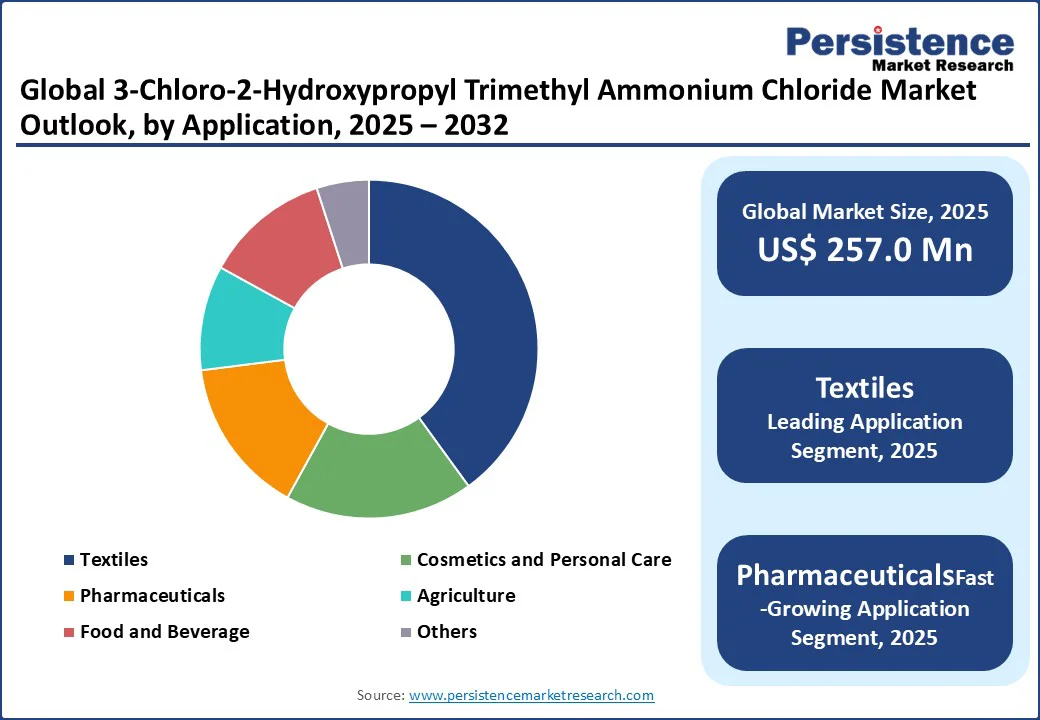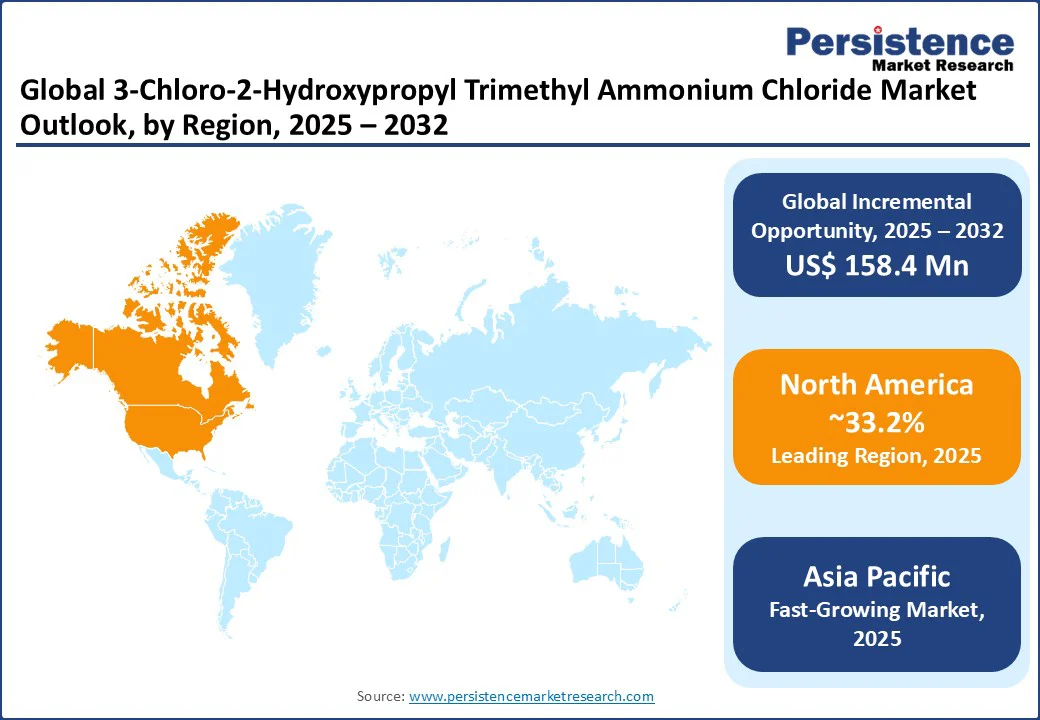ID: PMRREP11242| 191 Pages | 1 Sep 2025 | Format: PDF, Excel, PPT* | Chemicals and Materials

The global 3-chloro-2-hydroxypropyl trimethyl ammonium chloride (CHPTAC) market is projected to grow from US$257.0 Mn in 2025 to US$415.4 Mn by 2032, registering a CAGR of 7.1% during the forecast period from 2025 to 2032.
The market is consistently growing, driven by rising demand for cationic agents across diverse industrial applications. Their increasing use in textiles for dye retention, paper processing for improved strength, and water treatment for contaminant removal is fueling expansion. Additionally, innovative formulations from leading brands enhance performance, sustainability, and application versatility, supporting long-term growth.
Key Industry Highlights:

|
Global Market Attribute |
Key Insights |
|
CHPTAC Market Size (2025E) |
US$257.0 Mn |
|
Market Value Forecast (2032F) |
US$415.4 Mn |
|
Projected Growth (CAGR 2025 to 2032) |
7.1% |
|
Historical Market Growth (CAGR 2019 to 2024) |
6.5% |
The 3-chloro-2-hydroxypropyl trimethyl ammonium chloride (CHPTAC) market is propelled by increasing demand for cationic agents and their growing use as functional enhancers in textiles, paper, and water treatment industries. The global rise in industrial applications, particularly in textile modification and paper strengthening, has driven demand for effective, chemical-derived agents such as CHPTAC. Urbanization and rapid industrial growth continue to fuel demand for high-performance materials. CHPTAC is widely used in textiles for cationization, in paper for wet-strength enhancement, and in water treatment for flocculation, offering significant functional benefits. In markets such as the U.S., manufacturers are increasingly adopting CHPTAC as a cost-effective alternative to traditional chemical agents, with industry reports indicating a notable increase in its use in textile processing.
Government-backed industrial initiatives further support market growth. In India, programs such as the Make in India campaign have promoted the use of advanced chemicals in manufacturing and export sectors, emphasizing CHPTAC’s role in improving industrial efficiencies. For instance, the adoption of CHPTAC is high in Indian textile industries and is mainly used for dyeing and finishing processes. The expansion of the global chemical and textile industries has further driven CHPTAC adoption, with the compound serving as a cost-effective solution for enhancing product performance and meeting regulatory standards.
The CHPTAC market faces challenges due to concerns over environmental and health impacts, as well as high production costs. Some stakeholders question the safety of CHPTAC due to its chlorine content, which raises concerns about potential pollution and health risks, particularly in water treatment applications. A 2024 survey by the International Chemical Council found according to the new survey, 86% of responding chemical manufacturers said the overall level of regulatory burden has risen, particularly at the federal level, and they expect the volume of new regulations to rise even further across all levels of government a year from now. This skepticism limits adoption among eco-conscious industries, favoring greener alternatives.
High production costs for high-purity and sustainable CHPTAC also hinder growth. The synthesis of CHPTAC requires high-quality raw materials, such as trimethylamine and epichlorohydrin, which increase manufacturing expenses. For example, advanced production methods such as controlled chlorination can significantly raise costs, according to industry estimates. These costs are often passed on to consumers, limiting accessibility in price-sensitive markets such as rural India or Sub-Saharan Africa, where affordability remains a key barrier.
The CHPTAC market presents significant opportunities through innovation in clean-label formulations and sustainable sourcing. Growing demand for low-toxicity, environmentally friendly CHPTAC aligns with industry preferences for transparency and sustainability. Advanced CHPTAC formulations are gaining traction, driven by the need for eco-friendly industrial chemicals. Companies can capitalize by developing blends that combine CHPTAC with biodegradable agents, catering to both performance-driven and sustainability-conscious industries while meeting the needs of textile and paper manufacturers. SKW Quab Chemicals Inc. launched a low-impact CHPTAC variant that gained strong market response due to its eco-friendly certification.
Sustainable sourcing is another key growth avenue. With global emphasis on reducing environmental impact, brands are adopting responsibly sourced raw materials. In 2024, The Dow Chemical Company introduced sustainably sourced CHPTAC in Europe, enhancing brand loyalty among environmentally conscious manufacturers.
Companies such as Yanzhou Tiancheng Chemicals are exploring granular CHPTAC formulations to reduce production waste, aligning with regional sustainability goals in Asia Pacific. The rise of e-commerce platforms for industrial chemicals, including subscription-based and direct-to-manufacturer channels also creates opportunities. Brands are leveraging digital marketing and tailored product recommendations to reach niche industrial clients, such as textile and paper manufacturers, thereby expanding market reach and fostering loyalty.
The CHPTAC market is segmented into liquid, powder, and granular formulations. Liquid dominates the segment, expected to account for approximately 48.2% of the market share in 2025, due to its ease of application and strong functional profile in industrial processes. Brands such as The Dow Chemical Company and SKW Quab Chemicals Inc. have solidified their positions through advanced production and distribution capabilities. Its versatility in textiles and paper applications further drives adoption.
Powder is the fastest-growing segment, fueled by demand for stable, easy-to-store alternatives. Powder formulations appeal to industrial users, particularly in urban manufacturing hubs, where they are used in pharmaceuticals and textiles for their precise dosing and long shelf life. Products fortified with powder CHPTAC have gained traction for their efficiency and reduced environmental impact.
Textiles lead the application and is expected to account for 40% of the CHPTAC market share in 2025. Its dominance stems from widespread use in cationization for dyeing and finishing, competitive pricing, and industry preference for enhanced material properties. Companies such as Samsung Fine Chemicals and Sachem Inc. offer extensive CHPTAC ranges for textile processing, meeting the needs of global manufacturers.
Pharmaceuticals is the fastest-growing channel, driven by the rising use of CHPTAC in drug formulation and stabilization processes. The shift toward advanced chemical applications in healthcare, accelerated by post-COVID innovation, continues to boost this segment’s growth, with platforms expanding CHPTAC offerings for pharmaceutical-grade applications.
The chemical industry leads the end-use segments, expected to account for 70% of the CHPTAC market share in 2025. Its dominance is due to strict regulatory compliance and extensive use in chemical synthesis and processing. Companies such as Yanzhou Tiancheng Chemicals Co. Ltd. and Dongying Guofeng Fine Chemicals Co., Ltd. provide high-purity CHPTAC, ensuring reliability for industrial applications.
Healthcare is the fastest-growing segment, driven by increasing applications in pharmaceuticals and personal care. The rise of advanced chemical solutions in drug development and cosmetic formulations is fueling demand, with affordable and versatile CHPTAC enabling expansion in these sectors.

In North America, the U.S. dominates the sector, holding a market share of approximately 33.2% in 2025. This is driven by high industrial spending on advanced chemicals and a growing preference for efficient, sustainable solutions. The U.S. market is experiencing robust growth due to evolving industrial needs and increasing environmental consciousness. Liquid and powder-based CHPTAC lead the category, supported by the rising adoption in textiles and pharmaceuticals. Leading brands such as The Dow Chemical Company and Sachem Inc. are expanding their offerings in the chemical industry, while newer entrants gain traction with eco-friendly CHPTAC formulations.
Clean-label and sustainable options are increasingly important to U.S. industries. Brands such as SKW Quab Chemicals Inc. and Samsung Fine Chemicals are gaining popularity due to their transparent formulations and low-impact production methods. Sustainability is a major focus, with companies committing to eco-friendly sourcing and responsible manufacturing. In the premium segment, ethical sourcing and transparency are emerging as key differentiators.
Europe’s CHPTAC market is led by Germany, the U.K., and France, driven by stringent regulations and increasing demand for sustainable chemicals. Germany maintains the largest market share, with a strong focus on liquid and powder-based CHPTAC for textile and paper applications. The popularity of international brands such as The Dow Chemical Company, alongside local players, underscores this trend. Environmental policies under the EU’s Green Deal and restrictions on high-impact chemicals are encouraging companies to adopt sustainable solutions, with liquid formulations gaining traction.
In the U.K., the market is fueled by industries prioritizing low-toxicity, high-performance chemicals, particularly among textile and pharmaceutical manufacturers. Brands such as SKW Quab Chemicals Inc. and Sachem Inc. are expanding their offerings, emphasizing transparency and eco-friendly profiles. France is witnessing steady growth in pharmaceutical applications, with liquid CHPTAC leading in preference. Regulatory support for sustainable chemical use continues to drive market growth across the region.
Asia Pacific is expected to achieve a positive CAGR from 2025 to 2032. In India, textile and pharmaceutical applications dominate, driven by affordability and government-backed industrial initiatives such as Make in India. Leading players such as Yanzhou Tiancheng Chemicals Co., Ltd. and Dongying Guofeng Fine Chemicals Co., Ltd. have broadened their portfolios with liquid and powder-based options, targeting both urban and rural markets. The market is bolstered by increasing industrial awareness and rapid urbanization.
China’s growth is propelled by demand for functional enhancers in textiles and paper processing. Prominent brands such as Dongying J&M Chemical Co., Ltd. and Weifang Greatland Paper and Chemicals Co., Ltd. lead the segment. The expanding middle class and growing interest in advanced industrial solutions have significantly contributed to increased consumption, particularly in the chemical industry.

The CHPTAC market is highly competitive, with global giants and regional players vying for market share. Companies compete on innovation, pricing, and distribution efficiency. The rise of sustainable and low-toxicity chemicals has intensified competition, as industries demand transparency and environmental responsibility. Digital marketing and partnerships with textile and pharmaceutical manufacturers are key strategies for differentiation.
The CHPTAC market is projected to reach US$257.0 Mn in 2025.
Rising demand for cationic agents, industrial enhancement needs, and government-backed industrial programs are the key market drivers.
The CHPTAC market is poised to witness a CAGR of 7.1% from 2025 to 2032.
Innovation in clean-label materials and sustainable sourcing are the key market opportunities.
The Dow Chemical Company, SKW Quab Chemicals Inc., and Samsung Fine Chemicals are among the key market players.
|
Report Attribute |
Details |
|
Historical Data/Actuals |
2019 - 2024 |
|
Forecast Period |
2025 - 2032 |
|
Market Analysis |
Value: US$ Mn, Volume: As Applicable |
|
Geographical Coverage |
|
|
Segmental Coverage |
|
|
Competitive Analysis |
|
|
Report Highlights |
|
|
Customization and Pricing |
|
By Formulation Type
By Application
By End-use Industry
By Region
Delivery Timelines
For more information on this report and its delivery timelines please get in touch with our sales team.
About Author